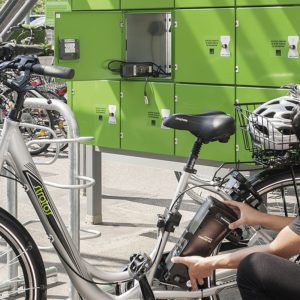E-bikes—already a big deal—are bound to get bigger. Analysts expect the global market to grow by 60 percent or more by 2025, with at least one major European bike maker projecting that it will soon sell more e-bikes than regular bikes. Giant, the world’s largest bike-maker, expects e-bike sales to increase by 30 percent this year.
Much of the growth has been attributed to the aging population. This might be true. Biking has obvious cardiovascular benefits for oldsters and some clinical trials have shown significant benefits for Parkinson’s patients. (So far, the benefits have been shown when the cadence is forced above what is natural for the patient, but new research is looking at benefits from a less aggressive pace.) At least one other study is looking possible benefits for Alzheimer’s patients.
Then there are the social benefits. It is liberating for older people to be rolling around on their own, whether it’s a spontaneous trip to a café or a boring errand to the supermarket. And for better or worse, an e-bike…any bike…is less isolating and encapsulating than a vehicle. You’re out in the world again. With its weather. And its potholes. And all the yahoos who are blind to pedestrians and bikers and anything but the SUV directly ahead.
And therein lies the great sandy rub: all bikes are dangerous and e-bikes maybe more so.
A few statistics illustrate the point. In Australia, cycling-related hospital admissions shot up by 60 percent between 2000 to 2016. People over 45 made up the majority of that increase, “with admissions booming by 466 percent. Older cyclists now make up a quarter of all riders admitted to hospital.”
E-bikes seem especially lethal. According to oft-cited statistics from the Netherlands, the “deaths of men over 65 using electric bikes on Dutch roads have caused the number of cycling fatalities in the country to surpass the people killed in cars.” Deaths on e-bikes nearly doubled in 2017, with around 75 percent of those deaths involving men 65 and older.
Over-confidence is one problem. (This might be especially so among Dutch men, who grew up in a biking culture.) But it isn’t the only one. In many (most) places in the U.S., biking infrastructure sucks. Until bikers are segregated from cars—or until drivers learn to respect bikers—two-wheeling seniors will die.
E-bikes might also cause some of the problem. On a long hill, the electric assist can make the difference between a pleasant ride and giving up in shame. On the flat or downhill, more power means more speed means a bigger rush and greater risk and a greater penalty if you fall.
Sadly, any bike fall at any speed at any age is bad. Too many hard surfaces to land on, too many obstacles to fall into (curbs, parked cars, oncoming traffic), too little protection except your helmet (unless you are an idiot and go pate-naked). Old people on bikes have high confidence in what they’re doing, but they have to realize that the cost of failure is high. (Just like Alex Honnold free climbing El Capitan in Free Solo.)
We can do more to reduce the risks. First is infrastructure: more bike paths, bike lanes, and better markings. Maybe higher fines for drivers who don’t respect the bike.
Second, more consistent regulation. Keep anything with a throttle off the bike lanes but allow devices that kick in with electric assist when you’re peddling. Require some orientation or licensing.
And for those who recognize their limits, a shift to three-wheeled e-bikes is a good idea. They exist, they are just as fun as regular e-bikes, they can haul more groceries and there’s less chance of a fall.
We don’t want to discourage anyone from getting on a bike and taking a chance. Life has risks, and you should take your fun where you can find it. Yes, you’ll be safer at home watch Jeopardy. But you were meant for more.
If you’re bi(cycle)-curious, here’s a good intro to e-bikes: https://www.youtube.com/watch?v=o0YaUlJqnMs
Photo: Rolf-Michael Röpke – E. ZIEGLER Metallbearbeitung AG, Im Bühl 12, D-71287 Weissach-Flacht, CC BY-SA 4.0
E-Bike-Ladeschliessfach – Search results for _e-bike_ – Wikimedia Commons 









